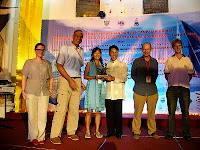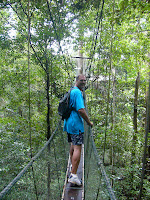We left Santubong on Friday, 25 Jun 2010 at about 1500 hours. We were planning to have an easy slow sail to arrive at the mouth of the Rajang River just after sunrise. However the wind did not cooperate and we had to motor sail. That meant we got to the mouth of the Rajang River in the dark.
During the night out at sea, we encountered many fishing boats. We came real close to one and actually went over their nets as they were frantically trying to get them in. We put our engine to neutral and floated over. All was well but that got our adrenaline going.
We arrived at the mouth of the Rajang River at about 0400 hours and with the full moon behind us, we worked our way up the river. As the tide was flowing out and we were fighting our way upriver, we decided to anchor off a tributary at 0830 hours to wait for the tide change. We also took the opportunity to take a nap and refresh ourselves. At 1100 hours, we weighed anchor and continued upriver, and arrived at Sarikei at 1500 hour.
Sarikei is a little town on the Rajang River, with mostly Chinese and Ibans. We only stayed the night and after topping up our diesel at the fuel dock, we left at 1200 hour the next day.
We continued upriver and motored past Bintangor, another little town and turned up into the Tulai River. Our destination was the longhouse, Rumah Lidam, where cruising friends told us we have to visit. We past many longhouses on our way up and at 1615 hours, we were anchored in front of the dock to Rumah Lidam. Before long, the children were gathered at the dock and screaming their welcomes.
The Ibans are the biggest indigenous population in Sarawak. They live in longhouses by the river. The Rajang River is the greatest river in Malaysia and is a lifeline for the people who live on its bank. A longhouse is constructed, well, long. It is then sub-divided into rooms. There is a long verandah outside the rooms. Behind the door is a little apartment, complete with living room, bedrooms and kitchens. The Ibans gather socially outside on the verandah.

 We were invited to visit the longhouse by Jampie, our host and after showers and dinner, we grabbed some beers and trekked over to the longhouse. We sat on the floor on the verandah and drank tuak with our hosts. Everyone came out and sat with us. Only a few of the Ibans there spoke English but that didn’t stop the others from visiting with us. They brought out bottles and bottles of tuak. Tuak is a rice wine made from sticky local rice and is a popular drink with the Ibans. We had a great time and it was soon time to leave and we made our way back to the boat for a good night’s sleep.
We were invited to visit the longhouse by Jampie, our host and after showers and dinner, we grabbed some beers and trekked over to the longhouse. We sat on the floor on the verandah and drank tuak with our hosts. Everyone came out and sat with us. Only a few of the Ibans there spoke English but that didn’t stop the others from visiting with us. They brought out bottles and bottles of tuak. Tuak is a rice wine made from sticky local rice and is a popular drink with the Ibans. We had a great time and it was soon time to leave and we made our way back to the boat for a good night’s sleep.The next day we hosted them on our boat and we made the children cookies, which they enthusiastically consumed - sometimes 3 or 4 at a time. They were happy campers.
The Tulai River is not on the charts and we are sure the longhouses are not on the tourist maps. That is a good thing because the week we spent there was so blissful. It was quiet and serene. The lightning bugs were all over the trees at night but the downside is there were mosquitoes too.
We left Rumah Lidam on Saturday, 3 July 2010 at 0800 hours and as we were bringing up the anchor, discovered the chain was wrapped around a log. Mark had to saw off the ends in order to untangle it from our chain, and after about a half hour, we were on our way upriver to Sibu. There were so much debris floating down and we had to avoid hitting them. Some of them were big logs, about half the length of Sari Timur so it was scary at times, but it was a nice motor upriver. We arrived at Sibu at 1400 hours and were anchored across from the waterfront. The current there is massive, roaring down from 3 to 7 knots. Logs continued to bombard us and we had to dislodge several during our stay.

Sibu is the gateway to the Rajang and the second largest town in Sarawak. It is a bustling and modern town and the main port of the Rajang Basin. It is also the wealthiest town on the Rajang Basin and is a jumping off point for embarking on a Rajang River journey. We went to church on Sunday and visited the central market after. The place was pulsating; people everywhere, cars were stopped all over the place and even the traffic police were busy writing out tickets for illegal parking and too busy to give directions. We walked all over, definitely looking like tourists. We had lunch at the Fisherman’s Restaurant, who serves local Melanau cuisine. The Melanaus are another indigenous people of Sarawak.
On Tuesday, 5 July 2010 we again weighed anchor to continue on to Miri. We backtracked our way down the Rajang and turned off into the Sungei Lebaan. From there, we went on the Loba Singat and the Batang Lassa. The Loba Singat is a very tiny river on our chart. The Batang Lassa is actually very wide and it ends up in the South China Sea. We were planning to anchor for the night just inside the river mouth but the shallow depth as well as the fact the wind had picked up and were causing lots of chop, made us decide to go for it without stopping to head straight for Miri.


















































